Nara is a charming and picturesque city in Japan, ideal for a quick getaway due to its compact size and proximity to Osaka and Kyoto. As the imperial capital during medieval times, it is renowned for its numerous temples and the freely roaming sika deer.
Be sure to bring your camera, as every corner of Nara is worth capturing.
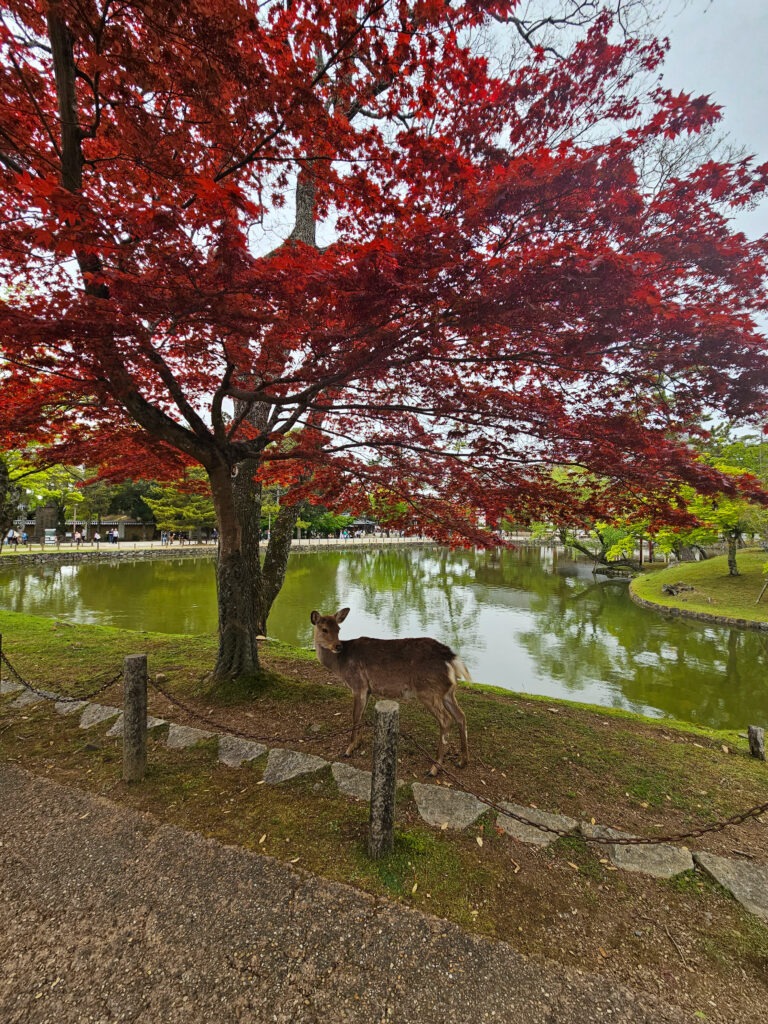
How long does it take to see Nara?
For many travelers, a day trip from Kyoto or Osaka is enough to see the highlights, such as Todaiji Temple, Nara Park, and Kasuga-Taisha Shrine.
However, if you enjoy leisurely exploration and want to discover every nook and cranny, staying overnight can be a great option.
While it’s challenging to see everything in one day, with good planning, you can cover the main attractions and get a comprehensive impression of Nara.

What to see and do in Nara
Nara is renowned for its impressive temples, many of which are UNESCO World Heritage Sites. These temples, among the oldest and best-preserved in Japan, are a must-see for any visitor.
Most temples are located in the vast Nara Park, the most touristic area and a perfect starting point for exploring the city. This park is famous not only for its temples but also for the deer that wander freely, adding a unique charm to your visit.
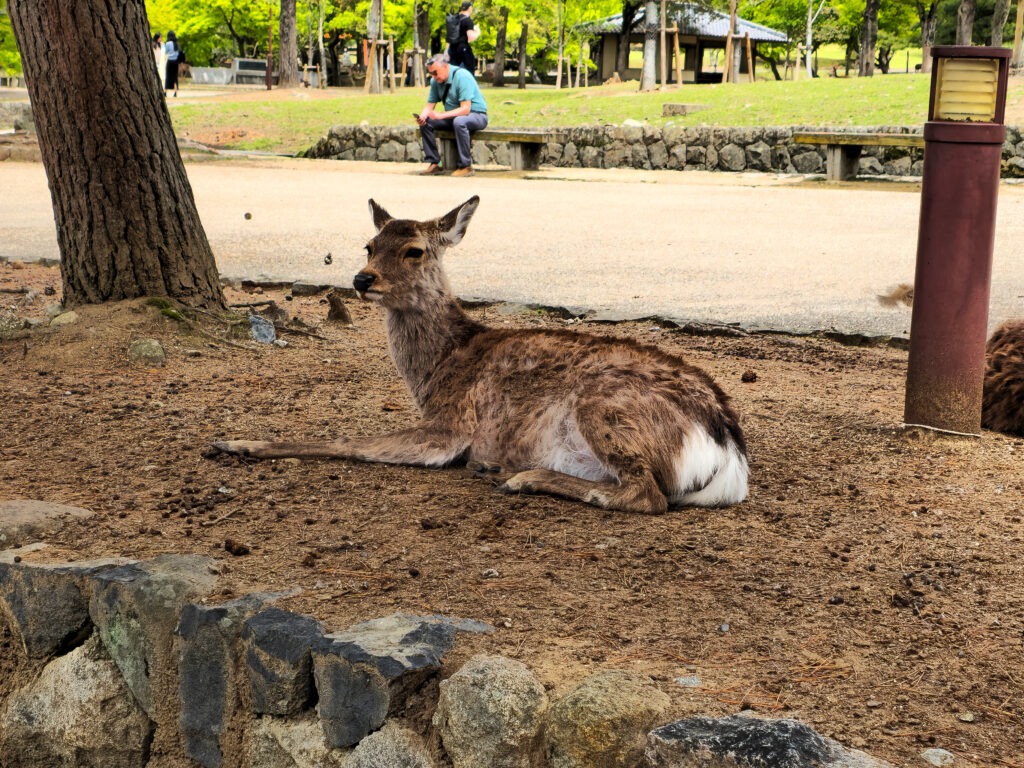
Nara Park is the tourist heart of the city, but Nara offers much more. Beyond the park, the city is rich in history, culture, and fascinating sites. So, while your tour may start in the park, be sure to take time to explore other parts of the city that are sure to surprise and delight you 😉.
Nara Park
Nara Park, located to the east of the city, is a must-see, especially known for its sika deer. These deer, revered as messengers of the gods in Shinto religion, are a symbol of Nara and are protected as a National Treasure. Approximately 1,200 deer roam the park, coexisting peacefully with both locals and tourists.
Established in 1880, the park spans nearly 600 hectares and features a variety of lakes, hills, temples, torii gates, shrines, and charming nooks. It is particularly stunning in autumn and spring when the maple and cherry trees are in full display. The park offers not only a chance to enjoy nature and wildlife but also an opportunity to explore the rich history and culture of the city through its numerous temples and shrines. A stroll through this park, amidst the serene lakes, rolling hills, and the company of deer, is reason enough to visit Nara.

One of the most delightful experiences is feeding the deer with rice crackers, known as shika senbei, which can be purchased around the park for about 150 yen. Some deer have even learned to bow in exchange for these treats, adding a humorous and memorable touch to the visit. However, it’s important to follow the rules and remember that, despite their tame appearance, the deer are wild animals and can bite if they feel threatened or get too excited about food.
While exploring the park, it’s common to see deer near temples and shops, and even crossing the roads. One highlight is the 20-metre-high Nandaimon Gate, a National Treasure, guarded by two imposing Niō statues over eight metres tall. This gate leads to Tōdai-ji Temple, one of the main attractions within the park.

- Nara Park is always open, allowing you to visit at any time of the day
- Admission is free.
Todai-ji Temple
Tōdai-ji Temple, known as the “Great Temple of the East”, is Nara’s most important and iconic temple. Built in 752 and rebuilt several times due to fires, it is a World Heritage Site. Despite being reduced in size by 33%, it remains the largest wooden building in the world, recently surpassed in size only by “Las Setas” in Seville.
Upon approaching the temple, you’ll be greeted by the Nandaimon Gate, almost 20 metres high, flanked by two enormous statues of the Nio guardians. This gate marks the beginning of your visit to Tōdai-ji and sets the stage for the grandeur inside.

The temple’s main pavilion, known as Daibutsuden or the Great Buddha Hall, houses the famous bronze statue of the Buddha, one of the largest in the world at 15 metres tall and weighing around 500 kg. The statue’s impressive dimensions include a head that measures 5.41 metres, ears that are 2.54 metres long, and eyes that are each 1 metre wide. Alongside the giant Buddha, the hall contains other guardian statues, enhancing the solemnity of the place.
The statue of the Great Buddha, made of 90% bronze and 10% gold, was a monumental project that nearly bankrupted Japan by depleting its reserves of these metals. Despite being recast multiple times due to fire and earthquake damage, it remains one of the country’s most revered and awe-inspiring attractions.

A popular curiosity for visitors is a hole at the base of one of the Daibutsuden’s columns, said to be the size of the Buddha’s nostril. Legend has it that those who manage to pass through it will attain enlightenment in their next life, resulting in long queues of tourists eager to give it a try.
- Todaiji Temple is open from 8am to 5pm from November to March, and from 7:30am to 5:30pm from April to October.
- The entrance fee is 600 yen.
- For more information, visit the official Todai-Ji website.
Nigatsudo Temple
After exploring Tōdai-ji Temple and admiring the large statue of Vairochana Buddha, I highly recommend heading over to Nigatsudo. This quieter, more elevated part of the complex is to the east of the Great Buddha and offers breathtaking views of Nara from its charming wooden balcony.
Climbing the stairs up to Nigatsudo is definitely worth it. You’ll be rewarded with an unparalleled view of the park and the city. Plus, admission is free and the temple is always open, making it a perfect spot for a relaxing break from sightseeing.
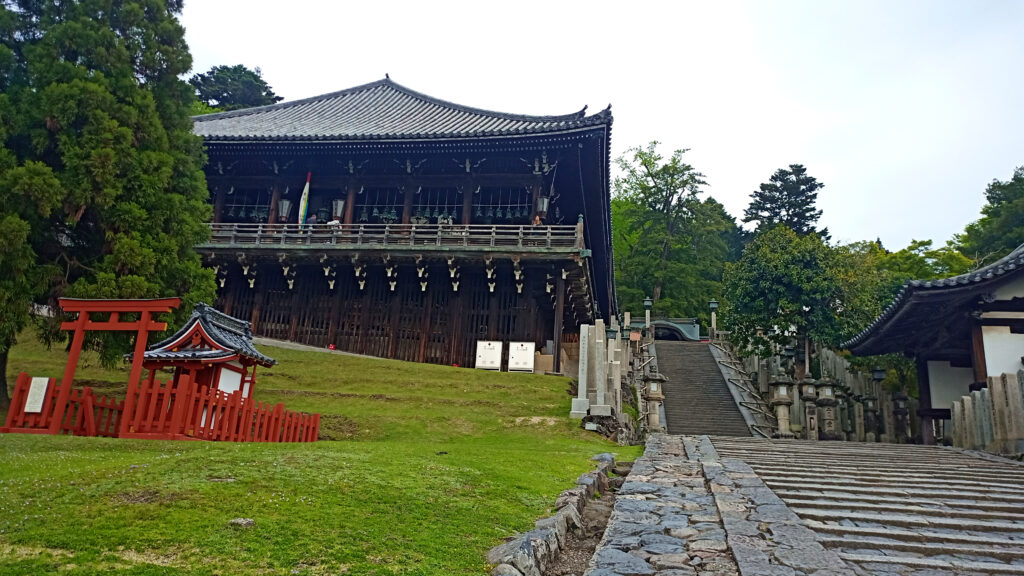
If you visit in early March, you can experience the Omizutori, a fire and water festival with over 1200 years of history. Known for its spectacular nighttime scenes, this event is one of Japan’s most photogenic festivals and a must-see if you’re in Nara during this time of year.
If you’re up for it, continue your walk to the top of Mount Wakakusa. The climb requires a bit of effort, but the views from the top are absolutely stunning, giving you a panoramic look at the entire Nara area.

- Nigatsudo Temple is open from 8am to 5pm from November to March, and from 7:30am to 5:30pm from April to October.
- Admission is free.
- For more information, visit the official Todai-Ji website.
Mount Wakakusayama
At the heart of Nara Park is Wakakusa Hill, a grassy mountain rising about 350 meters high in the eastern part of the park. It offers spectacular views of Nara and is the site of the unique and visually stunning Yamayaki festival.
Every year on the fourth Saturday in January, Wakakusa Hill becomes the center of attention with the Yamayaki festival, or “Mount Wakakusa in Flames.” During this event, the dry grass on the hill is set on fire in a controlled burn, creating a dramatic and impressive spectacle. One theory behind the festival’s origin is that it began due to a border dispute between Todai-ji and Kofuku-ji temples, which was resolved in the 18th century by burning the mountain.

Today, Yamayaki attracts locals and tourists from all over Japan and the world. The event includes a fireworks display, adding a magical touch to the night sky. Firefighters ensure the fire remains controlled and safe for all attendees.
Wakakusa Hill is open from 9:00 am to 5:00 pm. If you’re visiting Nara in January, this festival is a must-see. Watching the hill ablaze under the starry sky is an unforgettable experience.
Kasuga-Taisha Shrine
One of the most iconic places in Nara is Kasuga-Taisha Shrine, also known as the “Lantern Shrine”. Dedicated to the city’s patron deity, this Shinto shrine is famous for its history, architecture, and the thousands of bronze and stone lanterns that decorate the grounds.
Built in 768, Kasuga-Taisha Shrine used to be torn down and rebuilt every 20 years in an ancient Shinto tradition, a practice that has since ceased. Today, it is a UNESCO World Heritage Site and a Historic Monument of ancient Nara.
The shrine is adorned with about 3000 lanterns, including 2000 stone lanterns around the shrine and 1000 bronze lanterns hanging from the roofs and eaves. These lanterns were donated by the faithful, including former samurai seeking protection from the deity Hachiman during times of war.
The lanterns are lit twice a year, during the Setsubun Mantoro festival in February and the Obon Mantoro festival in August. These events create a magical atmosphere you shouldn’t miss if you’re in Nara during these times.

Surrounding the shrine is a lush forest, Kasugayama, also a World Heritage Site, where moss-covered stone lanterns add a touch of mysticism.
Nearby is the Kasuga Taisha Shinen Manyo Botanical Garden, home to 250 species of flowers, with wisteria blooming beautifully in late April and early May. If you visit Nara in spring, be sure to explore this garden and other cherry blossom viewing spots.
Kasuga-Taisha Shrine is open every day, with hours that vary by season. At the ticket office, you might be greeted by a miko, a Shinto priestess dressed in red and white, who can guide you during your visit.
- The shrine is open from 7am to 5pm from November to February and from 6:30am to 5:30pm from March to October.
- To enter the shrine itself, the fee is 500 yen (about €4).
- If you only want to explore the exterior and gardens, admission is free.
- The botanical garden also has an entrance fee of 500 yen.
- For more details, visit the official Kasuga Taisha website.
Kofuku-ji temple
Just a ten-minute walk from Kintetsu Nara Station, the ancient Buddhist temple of Kofuku-ji is a must-see in Nara. This temple, along with other historic buildings, was declared a UNESCO World Heritage Site in 1998 under the “Historic Monuments of Ancient Nara” designation.
Originally built in 669, Kofuku-ji was moved to its current location in Nara in 710, when the city was known as Heijo-kyo. The temple’s rich and complex history includes numerous rebuilds and restorations over the centuries.
While access to the temple complex is free, you’ll need to buy tickets to enter its three main buildings: the Central Golden Hall, the Eastern Golden Hall, and the National Treasure Museum. The Central Golden Hall (Chukondo), rebuilt in 2018 after a fire three centuries ago, is particularly impressive, both architecturally and for the many religious figures it houses.
You can also visit the Eastern Golden Hall, which contains a statue of the Yakushi Buddha, and the National Treasure Museum, which showcases a remarkable collection of Buddhist art.

Another highlight is the five-story pagoda, which stands 50 meters tall, making it the second tallest wooden pagoda in Japan, after Toji Temple in Kyoto.
- The temple’s outdoor area is open all day and free to explore.
- To enter the National Treasure Museum or the Central Golden Hall, you need a ticket costing ¥700 and ¥300 respectively, or you can buy a combined ticket for ¥900.
- Both buildings are open from 9:00 to 17:00.
- For more information, visit the official Kofuku-ji website.
Higashimuki Shopping Street
A must-visit in Nara is Higashimuki Street, a covered shopping arcade buzzing with life. Located just outside Kintetsu Nara Station, this is one of the busiest streets in the city, filled with a variety of shops and restaurants where you can immerse yourself in the local culture.
The first thing you’ll notice is the abundance of shops selling all sorts of items and souvenirs related to Nara’s famous deer. From T-shirts and plush toys to all kinds of deer-shaped sweets and snacks, it’s the perfect place to pick up a unique memento. Pay attention to the deer-decorated manholes, a detail that highlights Japan’s creativity and urban design care.

One highlight of Higashimuki is Nakatanidou Mochi, famous for its matcha mochis. This place has gained social media fame for the traditional and spectacular way the mochis are prepared. Several times a day, artisans pound the mochi dough with mallets, creating a rhythmic and captivating spectacle. Even though it was quite crowded when we visited and we could only watch briefly, these delicious mochis are definitely worth a try.
Naramachi
Exploring the Naramachi district is a great way to see a different side of Nara, away from the well-known temples. Located in the old part of the city, this charming neighborhood features narrow streets lined with traditional wooden houses, shops, and a variety of restaurants and small stores.
When Nara’s temples begin to close, Naramachi is an excellent place to explore. It’s an ideal spot to try local food in a traditional setting.
The old machiyas, now converted into shops, restaurants, or museums, add a nostalgic charm with their traditional architecture. Highlights include the Monogatari-kan art gallery, the Koshi-no-Ie Machiya for authentic local flavours, and the Imanishike Shoin residence, perfect for enjoying a cup of tea.

A charming aspect of Naramachi is the monkey-shaped good-luck charms, called migawari-zaru, that you’ll often see hanging on the doors of houses. These amulets are a part of local folklore and are believed to offer protection against bad luck. They also make for a meaningful souvenir to take home, embodying the rich traditions of Nara.
Do You Have More Time to Visit Nara?
If you have more days to explore Nara, here are a few recommendations:
Horyu-ji Temple
Horyu-ji Temple, located about 15 kilometers from central Nara in Ikaruga, is one of the oldest wooden temples in the world. Built in 607 by Emperor Suiko and Prince Shotoku, this UNESCO World Heritage Site shows influences from the Korean kingdom of Baekje.
To get there from Nara Station, take the Yamatoji Line and get off at JR Horyuji Station, followed by a 20-minute walk to the temple.
Though it’s a bit out of the way, it’s worth visiting for its impressive 5-story pagoda, standing almost 33 meters tall, and the Golden Kondo Hall in the Sai-in area.
The temple is divided into two main areas: Sai-in and To-in, where you can explore treasures from Buddhist art dating back to the 6th and 7th centuries.

- Horyu-ji is open from 8am to 4:30pm from November to February and from 8am to 5pm from February to November.
- The entrance fee is 1500 yen (about €12).
- PaFor more details, visit the official Horyuji website.
Yakushi-ji Temple
Yakushi-ji Temple, built in 680, is one of Japan’s oldest temples and holds historical and architectural significance in Nara.
Recognised as a UNESCO World Heritage Site, it is dedicated to Yakushi Buddha, known for his healing powers.
Commissioned by Emperor Tenmu for his ailing wife, who later became Empress Jito, the temple is noted for its perfect symmetry and distinctive design, including a large main hall and two three-story pagodas.
Originally located in Fujiwara-kyo and moved to Nara in the 8th century, the temple exemplifies the Yakushiji style with its symmetry and well-proportioned structures. It’s an important site in Japanese Buddhism, housing the Hossō school.
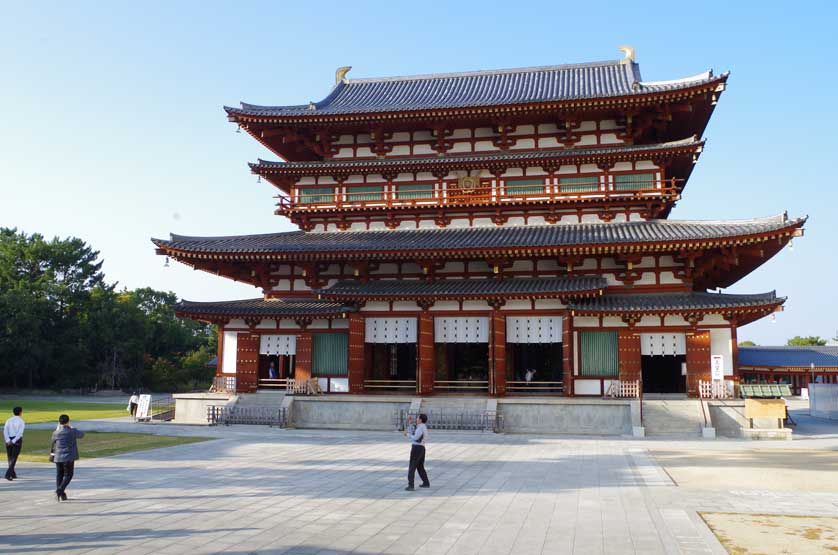
- Yakushi-ji Temple is open from 9am to 5pm.
- The entrance fee is 1000 yen (about €8).
- For more information, visit the official Yakushiji website.
Heijo Palace
Heijo Palace was the imperial residence during the Nara period (710-784) when Nara was the capital of Japan.
This UNESCO World Heritage site includes the emperor’s living quarters and government offices. Although it was abandoned after the capital moved to Kyoto, efforts have been made to reconstruct main buildings like the Daigokuden, a former audience hall.
It’s not located near Nara Park but can be reached by Gurutto bus from the train stations or by a 20-minute walk from Yamadato-Sadaiji or Shin-Omiya stations.

- Heijo Palace is open for free from Tuesday to Sunday, from 9:00 am to 4:30 pm.
- Admission is free.
- For more details, visit the official Heijo website.
Isuien Gardens
Near Todai-ji Temple, Isuien Gardens is perfect for a nature walk.
Established during the 17th and 19th centuries, the gardens feature a kaiyushiki teien style design with small central lakes surrounded by paths. The name, “garden founded on water”, comes from the ponds fed by the nearby Yoshikigawa River.
Admission is 1200 yen. The gardens are open every day except Tuesdays (though open on Tuesdays in April, May, October, and November) from 9:30am to 4:30pm.
Divided into two parts, the front garden dates back to the 17th century, while the larger back garden, built in 1899, has several teahouses scattered throughout.
In addition to its natural beauty, the Isuien Gardens also house the Neiraku Art Museum, which features a collection of ancient Chinese and Korean ceramics, seals, mirrors, and artifacts. The museum is included in the garden’s admission price, providing a broader cultural experience as you enjoy the tranquil surroundings.
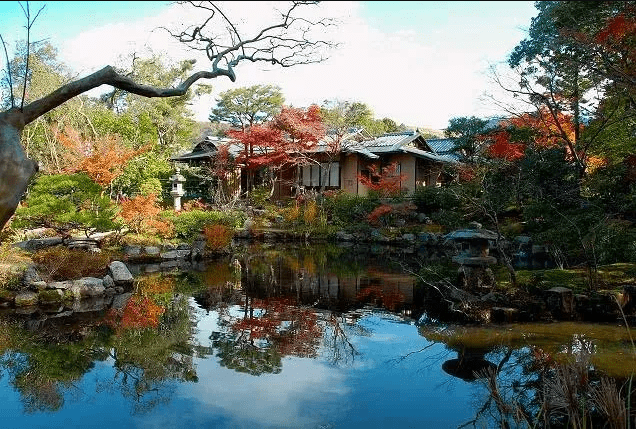
- The Isuien Gardens are open from 9:30am to 4:30pm. It’s a good idea to check their schedule before visiting, as they may be closed on Tuesdays and public holidays.
- Admission to both the garden and museum is 1200 yen.
- For more details, visit the official Isuien website.
Yoshiki-en Gardens
Yoshiki-en Gardens, situated by the Yoshikigawa River, offer a serene escape with three distinct styles of Japanese gardens.
Built on the site of former priestly residences of Kofuku-ji Temple, these gardens are a peaceful haven.
Admission to Yoshiki-en is free for foreigners and costs 250 yen for Japanese visitors. The gardens are open daily from 9:00 am to 5:00 pm.
The three main sections include a pond garden, a moss garden, and a garden designed for tea ceremonies, each offering a unique experience. This is a perfect spot to enjoy nature in Nara, with its tranquil ponds, arched bridges, and traditional teahouses providing a contemplative pause.
In autumn, the vibrant colors of the trees and moss create a spectacular landscape. It’s an ideal place to unwind after exploring Nara’s rich history.

- The gardens are open daily from 9:00 am to 5:00 pm.
- Admission is free.
- For more information, visit the official Yoshiki-en website.
Mount Yoshino
Mount Yoshino, or Yoshinoyama, is a fantastic destination if you have more time to explore Nara beyond its temples.
Known for its over 30,000 cherry trees, it offers a breathtaking visual spectacle during the sakura blossom in spring. From the top, you can enjoy panoramic views of Nara. The cherry trees at Yoshino have a history dating back more than 1,300 years, making it an iconic spot for hanami.
To get to Mount Yoshino, take the JR line from Nara Station to Yoshino-guchi Station, and from there, you can start your ascent. If you prefer a less strenuous journey, you can take a cable car up the mountain.

Museums in Nara
For art lovers and history buffs, Nara has several museums worth visiting.
The most renowned is the Nara National Museum, located in Nara Park. Established in 1889, it is one of Japan’s leading Buddhist art museums, featuring a permanent collection that includes impressive works like the 12th-century Hell Scroll, a mandala, and the 9th-century Yakushi Buddha sculpture. The museum also hosts temporary exhibitions, such as the annual Tōdai-ji Temple Treasures exhibition in autumn.
You might also want to visit the Naramachi Shiryokan History Museum to learn about traditional local life in Nara. Admission is free.
Lastly, the Nara Kogeikan Craft Museum showcases local handicrafts and is another spot to explore Nara’s cultural heritage.
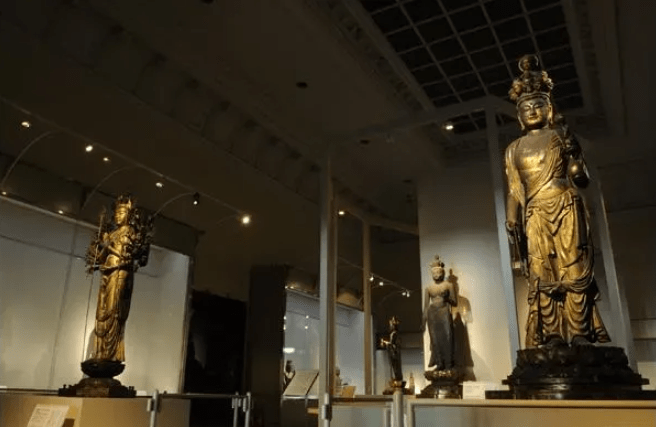
- The Nara National Museum is open from Tuesday to Sunday, 9:30am to 5p.
- It is closed on Mondays (or the following Tuesday if Monday is a holiday) and from December 28 to January 1.
- Admission is 700 yen.
- For more information, visit the Nara National Museum website.
- Naramachi Shiryokan History Museum is open from 10am to 4pm.
- Free admission.
- For more details, visit the Naramachi Shiryokan website.
- Nara Kogeikan Craft Museum is open from 10am to 6pm from Tuesday to Sunday.
- Admission is free.
- For more information, visit the Kogeikan Museum website.
Getting around Nara
Nara is perfect for exploring on foot, with its main attractions located close to each other.
However, if walking isn’t your preference, several bus lines can make getting around the city a breeze. Nara Kotsu buses cover all the major tourist sites and are a convenient option.
One great option is the Nara 1-Day Pass, which costs 500 yen per person and provides unlimited rides on local buses for a day. Two-day passes and other options tailored to different needs are also available. More information about these passes can be found on the official website.
Single bus tickets cost 210 yen per person. Unlike buses in cities like Kyoto, in Nara, you board at the front door and exit at the back, paying when you get on. Rechargeable cards such as Pasmo and Suica can also be used, making public transport even more convenient.
Here’s a map with all the bus lines:

How to Get to Nara
Getting to Nara by train is pretty straightforward, with two main stations: Kintetsu-Nara and JR Nara.
If you have a Japan Rail Pass, take a JR train to JR Nara Station. From Kyoto, the journey takes about 45 minutes and costs 710 yen if you don’t have the pass.
Without a JR Pass and looking for a faster option, take the Kintetsu Limited Express from Kyoto to Nara, which takes about 35 minutes and costs 1,130 yen with a seat reservation. This station is closer to the main attractions, saving you some walking.
From Osaka, if you have a JR Pass, take the JR Yamatoji Rapid Service Line, which takes about an hour. Without a JR Pass, the Kintetsu Nara Rapid Express line is your best bet, taking about 45 minutes.

Tips for visiting Nara
- Feeling overwhelmed with so much information and short on time? Don’t worry; it’s common among travelers. The key to a fulfilling day in Nara is to start early. Aim to arrive around 7:30 or 8:00 am when the attractions begin to open. This way, you can enjoy the main sites without feeling rushed.
- If you’re short on time, consider spending half a day in Nara and combining your visit with nearby destinations like Uji or the temples south of Kyoto. A classic combination is visiting Nara in the morning and Fushimi Inari Temple in Kyoto in the afternoon. To do this, take the JR Nara Line to Inari. Local trains are recommended over direct ones as they have stops near the shrine.
- Combining Nara with Inari is especially great in summer when the days are longer. In autumn, winter, and spring, with shorter days, you might need to plan more carefully to explore both places leisurely.

Where to stay in Nara
Nara offers a range of accommodation options to suit different tastes and budgets. From budget hostels costing around 20 euros per night to traditional and charming ryokan, which are about 100-120 euros per night. Ryokan provide an authentic Japanese experience with tatami rooms, onsen baths, and kaiseki meals.
🏡 Ryokan style with onsen:
If you prefer something more budget-friendly, this hotel offers spacious rooms and is right next to the JR train station:
🏨 Near JR train station:




